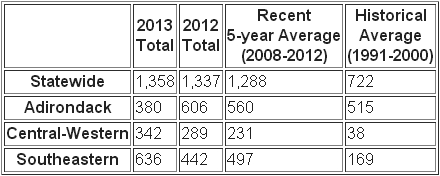 The Adirondacks are open for summer recreation, come and enjoy all that our lands and waters have to offer! Please be advised of the following conditions and prepare for them to ensure a safe and enjoyable outdoor recreational experience. This information focuses on the High Peaks Region, for more information or for information on other areas in the Adirondacks visit the DEC trail information web pages at: Adirondack Trail Information
The Adirondacks are open for summer recreation, come and enjoy all that our lands and waters have to offer! Please be advised of the following conditions and prepare for them to ensure a safe and enjoyable outdoor recreational experience. This information focuses on the High Peaks Region, for more information or for information on other areas in the Adirondacks visit the DEC trail information web pages at: Adirondack Trail Information
ADIRONDACK BACKCOUNTRY VISITORS
If you are recreating in the Adirondacks this Fourth of July Holiday weekend, the New York State Department of Environmental Conservation asks that you be aware of the following:
HIGH USAGE LEVELS: Visitors to the Adirondacks should expect to encounter more people on the water and trails this holiday weekend. Popular campgrounds, trailhead parking lots, boat launch sites and interior campsites will likely fill to capacity. The Eastern High Peaks may reach capacity by Thursday. Plan accordingly and seek recreational opportunities in other less used areas of the Adirondack Forest Preserve.
ESSEX CHAIN LAKES: 22 designated tent sites are currently available the area around the Essex Chain Lakes. Thirteen designated along the shores of the waters of the complex require a free permit. Campers must call 518-582-2000 or visit the Adirondack Interpretive Center facility at 5922 State Route 28N in Newcomb, NY, to reserve a tent site. Campers can pick up their reserved permit at the AIC facility between 9 a.m. and 7 p.m. any day of the week. See the Essex Chain Lakes Complex web page for more information on camping and other outdoor recreational opportunities in this area.
POOR MAN’S DOWNHILL SHUTTLE BUS: The Town of Wilmington will operate a shuttle bus for mountain bikers on Sunday July 6, between 1 pm and 4 pm. The shuttle will take mountain bikers from the downhill trailhead off Route 86 to the uphill trailhead off Route 431. The Poor Man’s Downhill is a multi-use trail on the northeast side of Whiteface Mountain. The trail begins just below the toll booth for the Whiteface Mountain Veteran’s Memorial Highway and ends 1,150 feet lower and nearly 3 miles away in the hamlet of Wilmington.
MUDDY & WET TRAILS: Mud and water will be present on all trails. Trails along water may be flooded. Wear waterproof footwear and gaiters and walk through – not around – mud and water to prevent eroding and widening the trail.
BEAR RESISTANT CANISTERS: Regulation requires the use of bear-resistant canisters by overnight users in the Eastern High Peaks Wilderness between April 1 and November 30. NYSDEC encourages the use of bear resistant canisters throughout the Adirondacks.
OTHER BEAR AVOIDANCE TIPS
- Store all food, toiletries and garbage in bear-resistant canisters.
- Outside the Eastern High Peaks Wilderness, if you don’t have a bear canister, hang food. Store all food, toiletries and garbage in the hang bag. Use a 75 ft. (25 m) long dark- colored cord. Hang the bag 15 ft (5 m) above the ground and at least 10 ft (3 m) away from trees.
- Keep food in bear-resistant canister or food hangs at all times – take down only what is needed for cooking and eating.
- Never leave food unattended unless it is in a bear-resistant canister or in a food hang.
- Cook early, no later than 5 p.m., and never cook or eat in your sleeping area.
BITING INSECTS: Black Flies, Mosquitoes, Deer Flies and/or Midges (No-see-ums) are everywhere. Follow these steps to minimize the nuisance of biting insects:
- Wear light colored clothing, long sleeve shirts and long pants;
- Tuck shirts into pants, the bottom of pant legs into socks and button sleeves at the wrist;
- Wear a headnet when insects are thick and use an insect repellant with DEET.
Visit the Adirondack Trail Information web page for current weather forecasts, regulations, safety tips, trail conditions, and more.
Enjoy your visit to the Adirondacks!
New York State Department of Environmental Conservation

 Regionally, bear hunters took a record 636 bears from the Southeastern bear hunting area and a near record 342 bears (2nd highest take) from the Central-Western bear hunting area. These high harvests reflect that bear populations have increased over the past decade. In addition, an abundance of hard mast (e.g., acorns and other nuts) kept many bears actively feeding later into the fall and available for harvest through the duration of the regular firearms season. Hunters took 224 bears in the Central-Western area and 431 bears in the Southeastern area during the regular firearms season. Bear populations in these ranges are in need of higher harvest rates in coming years in order to stabilize population growth generally and reduce populations in the Catskill region.
Regionally, bear hunters took a record 636 bears from the Southeastern bear hunting area and a near record 342 bears (2nd highest take) from the Central-Western bear hunting area. These high harvests reflect that bear populations have increased over the past decade. In addition, an abundance of hard mast (e.g., acorns and other nuts) kept many bears actively feeding later into the fall and available for harvest through the duration of the regular firearms season. Hunters took 224 bears in the Central-Western area and 431 bears in the Southeastern area during the regular firearms season. Bear populations in these ranges are in need of higher harvest rates in coming years in order to stabilize population growth generally and reduce populations in the Catskill region.





